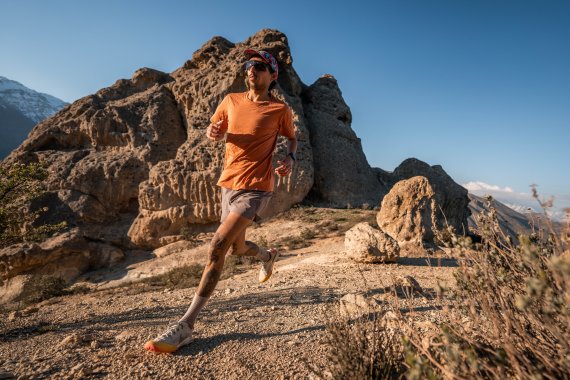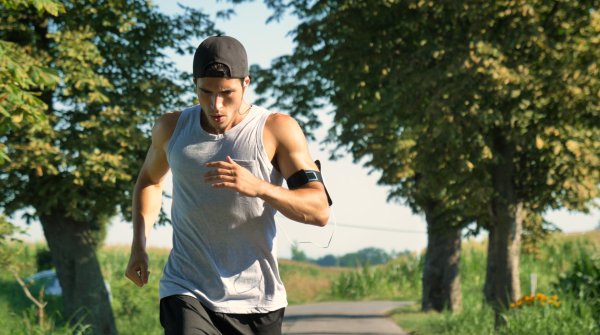
A majority of runners are said to have already experienced these perfect moments, the absolute running rush. Prof. Dr. med. Johannes Fuß, a specialist in psychiatry, psychotherapy and sexual medicine at the University of Duisburg-Essen, reveals in the AOK health magazine: "In our studies, about 70 percent of endurance athletes reported at least one runner's high in their lives. Some experience the high regularly, others never get to enjoy it."
These moments of happiness cannot be forced - as all reasonably ambitious runners know, and as doctors and experts confirm. The road to runner's heaven is winding and, above all, steep. But when the flow sets in, the euphoria is enormous, pain and fear disappear. Experiments with mice also confirm that hormones go on a merry-go-round at such moments. They feel less pain directly after extensive "training" in the running wheel and can run longer over a warm plate.
Those who enjoy Runner's High experience the art of running - legal doping through the unimagined abilities of their own bodies. Scientists believe that successful runners feel more creative, suffer less often from depression, work more productively and have more harmonious relationships. The U.S. sports physician Timothy Miller sums up the booster for body and mind this way: "For many people, the physical fitness they gain from running can improve job performance and even their sex lives." Well, if that's not one more reason to love what is perhaps the most sustainable sport.
When the endorphins tango - for many years, this was science's most plausible explanation for the state of intoxication during running or similar physical activities. But: Not true! Because the body's own happiness hormone, endorphin, does reduce pain. But it cannot trigger the runner's high and the flow, as expert Fuß explains: "The problem is that the endorphins are too large and do not pass from the blood into the brain. That's why the endorphins we measure in the blood have nothing at all to do with the endorphin level in the brain."
Instead, the so-called endocannabinoids are the key to happiness. The suspicious word component "cannabinoid" already hints at what it's all about: intoxication without smoke, middle-distance marijuana. The magazine Runner's World explains it this way, "Endocannabinoids are a natural version of THC - the chemical responsible for the high that marijuana produces." Virtually every cell in the body can secrete the endocannabinoids that create a sense of calm in moments of stress, such as running, relieve anxiety and reduce pain. As a result, they have a tremendous impact on the human brain - and they also play a crucial role in orgasm.
Running is the classic example of the runner's high - hence the name. But that's mainly because running is so widespread around the world and easily accessible to almost everyone. In general, however, "biker's high" or "swimmer's high" can also be experienced, as expert Johannes Fuß reveals: "Basically, it can occur wherever people maintain an athletic performance over a longer period of time, i.e. engage in endurance sports. People who row or cycle, for example, also report this high." And mental work can also lead to a very similar form of flow - anyone who has ever written themselves into a frenzy knows the score. But beware: intense stress, whether physical or mental, reduces the production of endocannabinoids and thus the chance of a "high."
The endocannabinoid high is legal, but just like illegal substances, it can be addictive. Once you've experienced this high, you want to enjoy it again and again - even if your body is sending other signals. And just as with drug abuse, higher and higher doses are often necessary so that the body and brain still get the hoped-for kick. This can lead to overexertion and injuries. Sports physician Miller warns, "Increasing mileage or intensity too quickly often provides overuse injuries."
Typical injuries then include stress fractures, ligament injuries or tendonitis. That's why it's important, especially for newcomers, to increase the demands slowly - and that running athletes never try to force the longed-for runner's high. Because pain is hardly felt during the flow, extreme athletes and very ambitious runners in particular literally run the risk of overtaxing their bodies and sustaining injuries.

The most important recipe is that there is no recipe for the runner's high. Even under identical circumstances, great happiness occurs one day - and mercilessly abandons the runner the next. That's why many runners experience such a flow once or twice in their lives, and never get into a comparable high again after that. But there are a few tips that can increase the chances of a runner's high.
- The right heart rate: Challenging the body but not overtaxing it - that's one of the keys to flow. Experts recommend running at 70 to a maximum of 85 percent of the age-dependent maximum heart rate. Little happens below that - and nothing above. At least a dozen formulas exist to calculate this so-called HRmax. One widely used model is "223 - 0.9 x age" for men and "226 - age" for women. So a 40-year-old woman has the best chance of flow if she runs with a pulse between 130 and 158.
- The right training duration: As a general rule, the runner's high only sets in after a good 30 minutes of running. One to two hours of training is considered particularly promising.
- Running together: If you run in pairs or in a group, you have a better chance of achieving a runner's high. However, it is unlikely that two or more runners will experience these moments of happiness together and at the same time.
- Get enough sleep: At least eight hours of sleep boosts the body's production of endocannabinoids - and with it, the chances of flow.
- Set concrete goals: If you set short-, medium- and long-term goals for running, you have a much higher chance of euphoria moments. After all, if you try to reach and exceed a certain average pace or a fixed distance, you'll be much more motivated than someone who just runs for fun. Important: Depending on the training condition, the goals must be adjusted again and again.
- Varied training: Runners who run at a constant pace are less likely to achieve a runner's high than runners who take intermediate spurts, who vary their pace repeatedly - and who thus sense how their body reacts to certain stresses.
- Choosing the right environment: Flow or not flow - that depends quite decisively on the atmosphere and the environment. Specialist Fuß recommends, "A nice atmosphere, for example, during a mountain run on vacation or your favorite music, could promote a runner's high."
- Thinking good thoughts: Thinking about moments of happiness from the past also helps. Sports medicine specialist Timothy Miller advises, "Think about your best running memory. Maybe it was a race where you faced a difficult challenge, where your mind and body were so attuned to you that it felt effortless to run your best time."
- Measuring success: External affirmations help in achieving the euphoria goal. It could be applauding spectators on the sidelines, the competition of running buddies you can keep up with - or simply a heart rate monitor that provides encouraging readings.
- Music: Letting your thoughts and your body run free - your favorite music from your headphones helps here, virtually putting a flow in your ears. If, on the other hand, you listen to complicated podcasts while running, which primarily occupy and strain your brain, you will have a harder time experiencing a runner's high.
- ISPO awards
- Mountain sports
- Bike
- Design
- Retail
- Fitness
- Health
- ISPO Job Market
- ISPO Munich
- ISPO Shanghai
- Running
- Brands
- Sustainability
- Olympia
- OutDoor
- Promotion
- Sports Business
- ISPO Textrends
- Triathlon
- Water sports
- Winter sports
- eSports
- SportsTech
- OutDoor by ISPO
- Heroes
- Transformation
- Sport Fashion
- Urban Culture
- Challenges of a CEO
- Trade fairs
- Sports
- Find the Balance
- Product reviews
- Newsletter Exclusive Area
- Magazine






